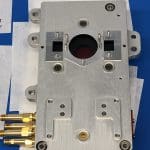Dual PEM
Dual PEM
Request QuoteDual PEM systems provide the capability to make real time polarization analysis measurements. When only one PEM is used, two measurements must be made with the sample rotated 45° after the first measurement. However, measurements can be made in real time using two PEMs mounted at 45° with respect to each other.
Hinds Instruments has four standard dual PEM choices. These are designed for applications that require different useful apertures and/or measurements in different spectral regions. The standard dual PEM models are:
The I/FS50-60 system (as well as the I/FS50-55 and I/FS47-50) uses the Series I PEM. The Series l PEM has a rectangular shaped optic that, in essence, limits the useful aperture of the PEM. These small systems are practical when the light source has a small beam diameter. Therefore, if the application for the dual PEM involves a light source consisting of only one laser, this is a viable option.
The II/FS20-23 and the II/FS42-47 systems also employ high quality fused silica as the optical material and have a transmission range of 170nm to 2.6µm. Both models are completely functional in the visible and near IR light spectral regions. However, the II/FS20-23 system has the benefit of a larger aperture. This is particularly useful if the light source has a large beam diameter or if more than one light source is to be accommodated. This dual PEM is typically used in a Stokes polarimeter system to measure the orientation of the linear component of light emitted from a beam of deuterium atoms injected into tokamak plasma. The II/42-47 is also used in Stokes polarimetry measurements and provides a more compact optical head configuration.
The II/ZS37-50 employs ZnSe as the optical material. This provides a quarter-wave modulation range of 2 μm to 18µm. This PEM pair has applications in the infrared region of the light spectrum. It can be used to analyze either a broadband light source or an infrared laser such as a CO2 laser.
Most dual PEM systems utilize Series II PEMs, which employ octagonal shaped optical elements. The Series II PEMs meet higher requirements for polarization modulation and offer symmetrical distribution of PEM retardation over a larger aperture range.
Like all Hinds PEMs, these systems provide the unique benefit of a wide acceptance angle (> ± 20 degrees), good transmission over a wide wavelength range, high power handling capabilities, and a high polarization sensitivity. The table above compares the technical specifications for all of the standard Hinds dual PEM systems. Customized dual PEMs are available.
Component Details
Custom configurations and accessories are available for this product family. Please contact a representative for more details.
Specifications
| Model | Optical Material | Retardation Range - Quarter Wave | Retardation Range - Half Wave | Useful Aperture |
| I/FS50-60 | Fused Silica | 170 nm – 2 μm | 170 nm – 1 μm | 16 mm |
| II/FS20-23 | Fused Silica | 400 nm – 2 μm | 400 nm – 1 μm | 56 mm |
| II/FS42-47 | Fused Silica | 400 nm – 2 μm | 400 nm – 2 μm | 27 mm |
| II/ZS37-50 | Zinc Selenide | 2 μm – 18 μm | 1 μm – 10 μm | 14 mm |
Resources
Application Notes
Worldwide Offices
Africa
Hinds Instruments, Inc.
7245 NE Evergreen Pkwy
Hillsboro, OR 97124
USA
Phone: 1.503.690.2000
Fax: 1.503.690.3000
Email: sales@hindsinstruments.com
Americas
Hinds Instruments, Inc.
7245 NE Evergreen Pkwy
Hillsboro, OR 97124
USA
Phone: 1.503.690.2000
Fax: 1.503.690.3000
Email: sales@hindsinstruments.com
India
Laser Science Services (I) Pvt. Ltd.
Offices in Navi Mumbai, Chennai, Delhi, Kolkata
Head Office:
A-454, TTC Industrial Area
MIDC, Mahape
Navi Mumbai, 400 710
INDIA
Phone: 91-22-41553232
Fax: 91-22-27781672
Email: sales@laserscience.in
Website: http://laserscience.co.in/
Japan
Tokyo Instruments Inc.
Attn: Mr. Ryutaro Shimada
T.I.Building,
6-18-14 Nishikasai Edogawa-Ku,
Tokyo 134-0088
JAPAN
Phone: +81 3 (3686) 4711
Fax: +81 3 (3686) 0831
Email: sales@tokyoinst.co.jp
Website: https://www.tokyoinst.co.jp
PR China (Integrated Components)
Aunion Tech Co Ltd – China HQ
Attn: Jinlong Wu
3rd Floor, Building 6,
2007 Hongmei Road,
Xuhui District, Shanghai, 200233 P.R. China
Phone: +86-21-51083793
Fax: +86-21-34241962
URL: www.auniontech.com
Aunion Tech Co Ltd – Shenzhen Branch
Attn: Mary Ma
Phone: 182-2167-2726
Email: lili-ma@auniontech.com
URL: www.auniontech.com
Aunion Tech Co Ltd – Beijing Branch
Attn: Allen Tian
Phone: 185-0166-2513
Email: jinquan-tian@auniontech.com
URL: www.auniontech.com
Aunion Tech Co Ltd – Wuhan Branch
Attn: William Zhao
Phone: 130-5208-0953
Email: Weiliang-Zhao@auniontech.com
URL: www.auniontech.com
Aunion Tech Co Ltd – Xi’an Branch
Attn: Jian Wang
Phone: 180-864-6606
Email: jian-wang @auniontech.com
URL: www.auniontech.com
Aunion Tech Co Ltd – Chengdu Branch
Attn: Yi Liu
Phone: 185-1625-1865
Email: yi-liu@auniontech.com
URL: www.auniontech.com
OPCrown Photonics Co Ltd – Beijing HQ
12B18, Changyin Bdg, No. 88 Yongding Rd
Haidian District, Beijing, P.R. China, 100039
Phone: 010-68214292
Fax: 010-68214191
Email: sales@opcrown.com
Attn: Rose Zhong
Phone 131 6171 4851
EMail: rose.zhong@opcrown.com
URL: www.opcrown.com
OPCrown Photonics Co Ltd – Wuhan Branch
Attn: Paul Liu
Phone: 137 9705 5601
Email: paul.liu@opcrown.com
OPCrown Photonics Co Ltd – Su Zhou Office
Attn: Sharon Ji
Phone: 188 6212 1645
Email: sharon.ji@opcrown.com
OPCrown Photonics Co Ltd – Chengdu Office
Attn: Bryan Zhang
Phone: 185 8378 9679
Email: bryan.zhang@opcrown.com
OPCrown Photonics Co Ltd – Shenzhen Branch
Attn: Nick Yuan
Phone: 136 3160 6196
Email: nick.yuan@opcrown.com
PR China (Research Components)
Aunion Tech Co Ltd – China HQ
Attn: Jinlong Wu
3rd Floor, Building 6,
2007 Hongmei Road,
Xuhui District, Shanghai, 200233 P.R. China
Phone: +86-21-51083793
Fax: +86-21-34241962
Website: https://www.auniontech.com/
South Korea
Opto Mechanical Associates (OMA) Co.
405-11,
Goong-dong,
Yusung-gu Daejeon 305 335
KOREA
Phone: +82 42 822 9501-3
Fax: +82 42 822 9504
Email: mail@omacom.co.kr
Website: https://www.omacom.co.kr
Taiwan (Integrated Components)
Aunion Tech Co Ltd
Attn: Jinlong Wu
Rm. 905, F Building,
Everbright Convention and Exhibition Center,
No. 86 Caobao Road, Shanghai 200235 P.R. China
Phone: +86-21-51083793
Fax: +86-21-34241962
Email: jinlong-wu@auniontech.com
URL: www.auniontech.com
OPCrown Photonics Co Ltd
Room 318, East 11th Bldg, No. 83 Fuxing Rd
Haidian District, Beijing, P.R. China, 100039
Phone: 010-68214292
Fax: 010-68214191
Email: sales@opcrown.com
URL: www.opcrown.com
Taiwan (Research Components)
Aunion Tech Co Ltd
Attn: Jinlong Wu
Rm. 905, F Building,
Everbright Convention and Exhibition Center,
No. 86 Caobao Road, Shanghai 200235 P.R. China
Phone: +86-21-51083793
Fax: +86-21-34241962
Email: jinlong-wu@auniontech.com
Website: https://www.auniontech.com/
Australia
Hinds Instruments, Inc.
7245 NE Evergreen Pkwy
Hillsboro, OR 97124
USA
Phone: 1.503.690.2000
Fax: 1.503.690.3000
Email: sales@hindsinstruments.com
Austria
Acal BFi Germany GmbH
Oppelner Straße 5
82194 Gröbenzell
GERMANY
Contact: Robert Kardinal
Phone: +49 (0) 8142 6520 119
Fax: +49 (0) 8142 6520 190
Email: robert.kardinal@acalbfi.de
Website: http://www.acalbfi.de/photonics
Belarus (Research Components)
SPECTROPOL
ul. Trakt Lubelski 271 G
04-667 Warszawa
POLAND
Phone: +48 22 617 67 17
Fax: +48 22 617 67 97
Email: biuro@spectropol.pl
Website: http://www.spectropol.pl/
Czech Republic (Research Components)
SPECTROPOL
ul. Trakt Lubelski 271 G
04-667 Warszawa
POLAND
Phone: +48 22 617 67 17
Fax: +48 22 617 67 97
Email: biuro@spectropol.pl
Website: https://www.spectropol.pl
Denmark
Acal BFi Nordic AB (Denmark)
Jernbanegade 23 B
DK-4000 Roskilde
DENMARK
Phone: +45 (0) 7026 2225
Fax: +45 (0) 7026 2221
Email: info@acalbfi.dk
Website: https://www.acalbfi.com/se
Estonia (Research Components)
SPECTROPOL
ul. Trakt Lubelski 271 G
04-667 Warszawa
POLAND
Phone: +48 22 617 67 17
Fax: +48 22 617 67 97
Email: biuro@spectropol.pl
Website: https://www.spectropol.pl
Finland
Acal BFi Nordic AB (Finland)
Teknobulevardi 3-5
FI-01530 Vantaa
FINLAND
Phone: +358 (0) 207 969 770
Fax: +358 (0) 207 969 771
Email: info@acalbfi.fi
Website: https://www.acalbfi.com/se
France
Acal BFi France SAS
1 allée de la Chartreuse
91080 Evry-Courcouronnes
FRANCE
Contact: Jocelyn TANAÏS
Phone: +33 (0) 1 60 79 59 06
Fax: +33 (0) 1 60 79 89 01
Email: photonique.fr@acalbfi.fr
Website: https://www.acalbfi.com/fr
Germany
Acal BFi Germany GmbH
Oppelner Straße 5
82194 Gröbenzell
GERMANY
Contact: Robert Kardinal
Phone: +49 (0) 8142 6520 119
Fax: +49 (0) 8142 6520 190
Email: robert.kardinal@acalbfi.de
Website: https://www.acalbfi.com/de
Ireland
Acal BFi UK Limited
Room 1.09
Challenge House
Sherwood Drive
Bletchley
Milton Keynes
MK3 6DP
UNITED KINGDOM
Phone: +44 (0) 1189 788 878
Fax: +44 (0) 1908 221 110
Email: sales-uk@acalbfi.co.uk
URL: www.acalbfi.com/uk
Acal BFi UK Limited
3 The Business Centre
Molly Millars Lane
Wokingham
Berkshire
RG41 2EY
UNITED KINGDOM
Phone: +44 (0) 1189 788 878
Fax: +44 (0) 1189 776 095
Email: sales-uk@acalbfi.co.uk
URL: www.acalbfi.com/uk
Italy
Acal BFi Italy S.r.I.
Via Cascina Venina n.20
20090 Assago
Milan
ITALY
Phone: +39 (02) 53583.1
Fax: +39 (02) 53583201
Email: sales-it@acalbfi.it
URL: www.acalbfi.com
Laser Optronic SRL
Via Bernardo Quaranta, 57
20139 Milano (MI)
ITALY
Phone: +39 (02) 574651
Fax: +39 (02) 57410127
Email: lop@laseroptronic.it
Latvia (Research Components)
SPECTROPOL
ul. Trakt Lubelski 271 G
04-667 Warszawa
POLAND
Phone: +48 22 617 67 17
Fax: +48 22 617 67 97
Email: biuro@spectropol.pl
Website: https://www.spectropol.pl/
Lithuania (Research Components)
SPECTROPOL
ul. Trakt Lubelski 271 G
04-667 Warszawa
POLAND
Phone: +48 22 617 67 17
Fax: +48 22 617 67 97
Email: biuro@spectropol.pl
Website: https://www.spectropol.pl/
Norway
Acal BFi Nordic AB (Norway)
PO Box 74
3529 Ryse
NORWAY
Phone: +47 3216 2060
Fax: +47 3216 2069
Email: info@acalbfi.no
Website: https://www.acalbfi.com/se
Poland (Research Components)
SPECTROPOL
ul. Trakt Lubelski 271 G
04-667 Warszawa
POLAND
Phone: +48 22 617 67 17
Fax: +48 22 617 67 97
Email: biuro@spectropol.pl
Website: https://www.spectropol.pl
Slovakia (Research Components)
SPECTROPOL
ul. Trakt Lubelski 271 G
04-667 Warszawa
POLAND
Phone: +48 22 617 67 17
Fax: +48 22 617 67 97
Email: biuro@spectropol.pl
Website: https://www.spectropol.pl
Sweden
Acal BFi Nordic AB (Sweden)
Falhagsleden 59
PO Box 1335
SE-751 43 Uppsala
SWEDEN
Phone: +46 (0) 1856 5830
Fax: +46 (0) 1869 6666
Email: info@acalbfi.se
Website: https://www.acalbfi.com/se
Switzerland
GMP SA
Avenue des Baumettes 17
CH – 1020 Renes
Phone: +41 21 633 21 21
Fax: +41 21 633 21 29
Email: info@gmp.ch
Website: https://www.gmp.ch
The Netherlands
Alphen aan den Rijn
Acal BFi Netherlands BV
J.P. Thijsseweg 1e
2408 ER Alphen aan den Rijn
THE NETHERLANDS
Phone: +31 (0) 1 7244 6060
Fax: +31 (0) 1 7244 3414
Email: sales-nl@acalbfi.nl
URL: www.acalbfi.com/nl
Eindhoven
Acal BFi Netherlands BV
Luchthavenweg 53
5657 EA Eindhoven
THE NETHERLANDS
Phone: +31 (0) 4 0250 7400
Fax: +31 (0) 4 0250 7409
Email: sales-nl@acalbfi.nl
URL: www.acalbfi.com/nl
Ukraine (Research Components)
SPECTROPOL
ul. Trakt Lubelski 271 G
04-667 Warszawa
POLAND
Phone: +48 22 617 67 17
Fax: +48 22 617 67 97
Email: biuro@spectropol.pl
Website: https://www.spectropol.pl
United Kingdom
Milton Keynes
Acal BFi UK Limited
Room 1.09
Challenge House
Sherwood Drive
Bletchley
Milton Keynes
MK3 6DP
UNITED KINGDOM
Phone: +44 (0) 1189 788 878
Fax: +44 (0) 1908 221 110
Email: sales-uk@acalbfi.co.uk
URL: www.acalbfi.com/uk
Wokingham
Acal BFi UK Limited
3 The Business Centre
Molly Millars Lane
Wokingham
Berkshire
RG41 2EY
UNITED KINGDOM
Phone: +44 (0) 1189 788 878
Fax: +44 (0) 1189 776 095
Email: sales-uk@acalbfi.co.uk
URL: www.acalbfi.com/uk
Middle East
Hinds Instruments, Inc.
7245 NE Evergreen Pkwy
Hillsboro, OR 97124
USA
Phone: 1.503.690.2000
Fax: 1.503.690.3000
Email: sales@hindsinstruments.com
Get A Quote for Systems & Components
Working together, we can discuss the suitability of our technology for your application, including a custom configuration of our base systems if needed.
Featured Article

JPL and Hinds Instruments: Celebrating Nearly Two Decades of Collaborative Design to Put PEMs in Space Under NASA Projects
JPL and Hinds Instruments team up to put PEMS in space under NASA projects.
Hinds Instruments © 2024. All Rights Reserved. Built with ♥ by Webfor

